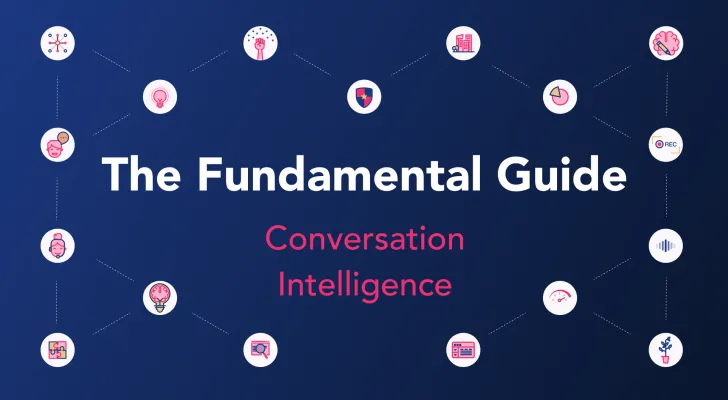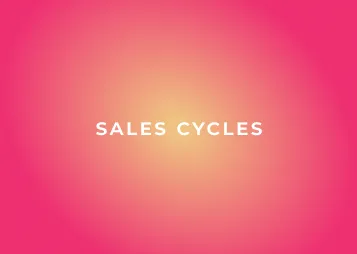In any field, the most successful performers are are constantly analyzing the results of their processes with a view to driving growth, development and progression. In today’s fast and highly-competitive B2B sales market, if teams are going to achieve success, they need to double-down on best practices and make their activities as efficient and effective as possible.
If you're a sales team manager, or even a sales rep aspiring to be part of a high-performing sales team, we'll take you through some B2B sales best practices based on research and experience.
The state of B2B sales today
With automated selling techniques becoming more and more common and the number of players in each market increasing by the day, it's getting harder to stand out from the crowd in B2B markets. You sales call or pitch is rarely the be-all and end-all.
Almost all B2B sales now begin with a buyer searching online to solve a problem. The speed and ease with which users can consume information online make it far superior than picking up the phone and allows them to compare more options, more comprehensively.

In our experience, many B2B customers also tend to ask for recommendations from friends, colleagues and on social media as part of their buying journey. They review platforms like G2 to find out what other people are saying and learn about experiences relevant to them and their industry as a specific buyer persona.
They might be enticed to click on a Google or social media ad whilst researching, and at that stage, they may reach out to the supplier for more information. But there's no guarantee of where they are in their decision-making process when they first make contact.
In other words, there is no straight-forward route for the B2B buyer on their journey. They’re loaded with information from various websites, social media, forums, and more before they start a conversation with a salesperson.
To succeed in modern-day B2B sales, we need to understand what the buying habits and behaviors are of the B2B buyer, as well as getting to grips with the factors influencing their decisions
We need data to determine how to connect with the customer, and how to build a solid relationship to sell your product or service in this advanced marketplace.
Buyer enablement in B2B sales
Gartner research found that when B2B buyers are considering a purchase‚ they spend only 17% of that time meeting with suppliers.
When buyers are comparing multiple suppliers‚ the amount of time spent with any individual sales rep may be only 5% or 6%.
Today, B2B sales teams need to consider how the information they share will assist in driving purchases and more sales.
Buyers have expressed preference towards sales information being concise and reps answering their questions quickly and efficiently. Research has shown these responses increase ease of purchase by 2.8 times and make the buyer three times more likely to agree to an increased deal size.
Making the buying process supportive, helpful, and easy to navigate is now a must-have for sales teams in this market. This is called “buyer enablement” and it's all about creating a B2B sales process that benefits the buyer in more ways than one.
Let's get into it!

8 B2B sales best practices
#1 Build a great sales team
Having a diverse group of salespeople that are open to listen, learn and grow is so important to any B2B sales team. Having great salespeople that make lasting and memorable impressions, can learn quickly from mistakes, and show determination is important for any business. But none more so than B2B.
A mix of personalities, strengths and weaknesses means the team can learn from each other, adapt to your sales strategy and succeed together. Long term, it will also make for a more resilient team with lower staff turnover.
#2 Know your market
B2B buyers' needs and priorities differ from B2C so you need to be really clear on your market. Revisit the research that has been done before and assess what else you don't know:
- Conduct quality market research to get to know trends and behaviors.
- Know what your competitors are doing and why.
- Understand key challenges, pain point and opinions of your buyer personas.
All of these will help you position yourself when talking to potential buyers. Put yourself in the buyer's shoes so you have a strategy in place to answer any problems or queries ahead of time.
#3 Determine your ideal customer
Knowing who to target and when to reach out to them is important when sourcing quality leads with a strong chance of converting.
Background research on the stakeholders who have the authority to buy (like reading their company blog or social media feed) can help you realize when the time is right to launch you sales pitch, send some useful information, or hold back (for now).
#4 Remote sales pitches
The world of sales has changed. And chances are, you’re using video software like Zoom or Google Meet to hold your B2B sales meetings.
- Building an early rapport with a solid introduction can help you build trust with the customer and qualify your lead. Make sure you’re pitching in a way that shows what results and outcomes they will achieve if they buy from you.
- Explain how you are different from the competition, what makes you stand out (for them); and what value you will bring to their business.
- Try and be as human as you can on camera by going the extra mile to create an appealing video environment that will spark their interest.
Selling can be tricky and it’s important to stay resilient, motivated, and confident after your meetings, even if not all of them are plain sailing.
#5 Revisit your conversations with the best sales tools
Trying to improve sales performance and boost the pipeline is easier if you equip your team with the right platforms. LinkedIn, Sales Navigator, PlanHat, SalesForce - to name just a few - can help reps target and manage leads.
Sales Intelligence tools go further by capturing data and creating searchable playlists so you can easily find customer conversations that you can later review.
While revenue intelligence tools provide analysis as to where and why deals went well or wrong. These insights will give your team tools for self-reflection and then make actionable targets to improve and set achievable goals.
It can help you strategize accurate revenue goals and KPIs you can measure in sales. Find out more about conversation intelligence.
#6 Winning deals and retaining happy customers
If you win the deal, make sure the finance and customer success department is ready to send the due diligence and deliver the onboarding.
Ensuring your customer is happy they bought your product or service relies on the after-sales support they receive. A customer is more likely to stick with you, even if there are some teething problems, if you show you care.
If you don’t close the deal you can use this as a learning process to see what you can change for your next sales approach.
#7 Growing your productivity and revenue
We all want to improve. Smash targets. Outperform competitors.
Capturing, analyzing and making data actionable is great for B2B sales teams as they have the metrics to help improve their performance. Tools that give you actionable insights following your conversations are crucial for sales teams to develop and learn fast.
#8 B2B sales training, coaching and team bonding
Communicating well with your team is so important. The team needs to work well together, have a common goal, and have a relevant reward system that will keep everyone motivated.
Celebrating successes openly and helping each other when things are difficult is all about good communication. This is key to retaining a hardworking, happy B2B sales team. Teams that keep united are more likely to succeed in meeting their goals.
Investing time in your team’s career development with training, coaching, and bonding sessions can help your reps improve with bigger wins. When the team bonds well, every salesperson is more likely to participate and stay motivated to accomplish their targets. The business can grow with the team, celebrating wins along the way and supporting each other when collaboration and problem-solving is required.
The future of B2B sales teams
B2B sales is changing fast and sales teams need to keep up to survive and thrive. What used to work doesn’t anymore. The B2B buyer is mostly in control.
Younger professionals now have the power to make buying decisions and they are keen on using digital technologies to help them research and decide. They will use a mixture of online sources and content and prefer doing this rather than being pushed by a sales rep.
Salespeople should try to listen and understand their buyer’s needs and provide them with relevant, useful information rather than being “sold” to.
More time spent on nurturing a relationship with a potential customer through good-quality, relevant content can help build that trust to move the buyer forward in their journey.
The influence of social media and marketing has a big impact on the buying decisions of the customer. The content consumed from various channels influences buyers in powerful ways, as social proof and endorsement play convincing parts in a buying decision.
The people behind products are also taking a leading role in effective B2B sales, but the traditional sales pitch is dead. The top-performing salespeople nowadays are experts in their field, creating and sharing their own relevant content, from a personal point of view. This helps build trust, awareness and knowledge of the product. LinkedIn posts and podcast and event appearances build the personal brands of your team, raising the profile of your business.
Finally, aligning sales and marketing teams not only increases brand awareness but helps to hit revenue targets and goals. Make sure your entire revenue-generating function is highly focused on your sale pipeline, with clear roles and responsibilities towards collective sales goals. Giving a prospect a multitude of channels to come to you via social media, LinkedIn, email, webinar, an online review creates a functional and effective buyer journey, so you'll never miss an opportunity.





.webp)






